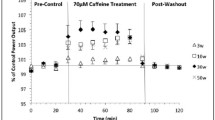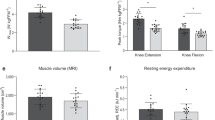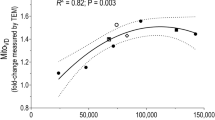Summary
Aging often results in a decline of most physiological systems of the body. However, the maintenance of some appropriate level of neuromuscular function into old age is critical if we expect the elderly to be able to maintain normal daily activity and functional independence. It is well established that muscular strength declines in old age, but an equally important parameter of neuromuscular function, muscular endurance, has received only minimal attention in the literature. Important information regarding age-associated changes in muscular endurance can be obtained from both animal and human research models, each having their own set of limitations and advantages. One problem in trying to interpret past research dealing in this area is the fact that muscular endurance can be expressed in a variety of ways and can be measured by a variety of techniques. It seems that conflicting reports arise from substantial differences in research design, statistical analyses or the ability to control extraneous influences such as physical activity levels and dietary intakes.
This review will examine both human and animal literature in an attempt to elucidate methodological concerns in the assessment of muscular endurance and the controversial evidence regarding changes in muscle morphology and muscle metabolism that may be responsible for age-related changes in muscular endurance. Issues that address the possible selective loss of fibre type and the declines in both total fibre number as well as fibre size will be presented, since muscle quantity and quality have obvious links to endurance capacity. In conjunction with the alterations reported in skeletal muscle tissue, muscle blood flow and the relationship between fibre and capillary numbers and their possible influences on substrate availability will also be discussed in relation to muscle endurance capabilities. Finally, the adaptive ability of aged skeletal muscle to improve muscular endurance by different training regimens and through different physiological mechanisms will be investigated.
Similar content being viewed by others
References
Novak LP. Aging, total body potassium, fat free mass, and cell mass in males and females between ages 18 and 85 years. J Gerontol 1972; 24: 438–43
Dutta C, Hadley E. The significance of sarcopenia in old age. J Gerontol A Biol Sci Med Sci 1995; 50: 1–4
Holloszy JO. Workshop on sarcopenia: muscle atrophy in old age. In: Holloszy JO, editor. J Gerontol A Biol Sci Med Sci 1995; 50: iii–156
Rogers MA, Evans WJ. Changes in skeletal muscle with aging: effects of exercise training. In: Holloszy JO, editor. Exercise and sport sciences reviews. Baltimore: Williams and Wilkins, 1993: 65–102
Evans WJ, Holloszy JO, Poehlman ET, et al. Sarcopenia: Age associated changes in muscle mass and quality. Med Sci Sports Exerc 1997; 29 Suppl.: S240
Frontera WR, Meredith CN, O’Reilly KP, et al. Strength conditioning in older men. Skeletal muscle hypertrophy and improved function. J Appl Physiol 1988; 64: 1038–44
Brown AB, McCartney N, Sale DG. Positive adaptations to weight-lifting in the elderly. J Appl Physiol 1990; 69: 1725–33
Fiatarone MA, Marks EC, Ryan ND, et al. High-intensity strength training in nonagenarians. JAMA 1990; 263: 3029–34
Klitgaard H, Mantoni S, Schiaffino S, et al. Function, morphology, and protein expression of ageing skeletal muscle: a cross-sectional study of elderly men with different training backgrounds. Acta Physiol Scand 1990; 140: 41–54
Charette S, McEvoy L, Pyka G, et al. Muscle hypertrophy response to resistance training in older women. J Appl Physiol 1991; 70: 1912–6
Grimby G, Aniansson A, Hedberg M, et al. Training can improve muscle strength and endurance in 78- to 84-yr-old men. J Appl Physiol 1992; 115: 125–43
Bemben MG, Massey BH, Bemben DA, et al. Isometric intermittent endurance of four muscle groups in men aged 20-74 yr. Med Sci Sport Exerc 1996; 28 (1): 145–54
White TP. Skeletal muscle structure and function in older mammals. In: Gisolfi CV, Lamb DR, Nadel E, editors. Perspectives in exercise science and sports medicine. Carmel (IN): Cooper Publishing Co., 1995: 115–69
Fitts RH, Troup JP, Witzmann FA, et al. The effect of ageing and exercise on skeletal muscle function. Mech Ageing Dev 1984; 27: 161–72
Faulkner JA, Brooks SV. Muscle fatigue in old animals. Unique aspects of fatigue in elderly humans. In: Gandevia SC, editor. Fatigue. New York: Plenum Press, 1995: 471–80
Larsson L, Grimby G, Karlsson J. Muscle strength and speed of movement in relation to age and muscle morphology. J Appl Physiol 1979; 46: 451–6
Aniansson A Grimby G, Rundgren A. Isometric and isokinetic quadriceps muscle strength in 70-year old men and women. Scand J Rehabil Med 1980; 12: 161–8
Sperling L. Evaluation of upper extremity function in 70-year old men and women. Scand J Rehabil Med 1980; 12: 139–44
Aoyagi Y, Shephard RJ. Aging and muscle function. Sports Med 1992; 14 (6): 376–96
Lennmarken C, Bergman T, Larsson J, et al. Skeletal muscle function in man: force, relaxation rate, endurance and contraction time-dependence on sex and age. Clin Physiol 1985; 5: 243–55
Bäckmann E, Johansson V, Häger B, et al. Isometric muscle strength and muscular endurance in normal persons aged between 17 and 70 years. Scand J Rehab Med 1995; 27: 109–17
McDonagh MJ, White MJ, Davies CT. Different effects of aging on the mechanical properties of human arm and leg muscles. Gerontology 1984; 30: 49–54
Davies CT, Thomas DO, White MJ. Mechanical properties of young and elderly human muscle. Acta Med Scand Suppl 1986; 711: 219–26
Edwards RT. Human muscle function and fatigue. In: McComas AJ, editor. Skeletal muscle form and function. Champaign (IL): Human Kinetics Publishers, 1996: 229
Monod H, Scherrer J. Capacité de travail statique d’un groupe musculaire synergique chez l’homme. CR Soc Biol 1957; 151: 1358–62
Deeb JM, Drury CG, Pendergast DR. An exponential model of isometric muscular fatigue as a function of age and muscle groups. Ergonomics 1992; 35 (7/8): 899–918
Rohmert W. Ermittlung von Erholungspausen für statische Arbeit des Menschen. Int Z Angew Physiol 1960; 18: 123–64
Ball TE, Massey BH. The stability and commonality of selected measures of endurance [abstract]. Med Sci Sports Exerc 1985; 17 (2): 250
Petrofsky JS, Lind AR. Aging, isometric strength and endurance 1975; 38 (1): 91–5
Clarkson PM, Kroll W, Melchionda AM. Age, isometric strength, rate of tension development and fiber type composition. J Gerontol 1981; 36: 648–53
Gutmann E, Hanzlikova V. Fast and slow motor units in aging. Gerontology 1976; 22: 280–300
Larsson L, Karlsson J. Isometric and dynamic endurance as a function of age and skeletal muscle characteristics. Acta Physiol Scand 1978; 104: 129–36
Tesch P, Sjodin B, Thorstensson A, et al. Muscle fatigue and its relation to lactate accumulation and LDH activity in man. Acta Physiol Scand 1978; 103: 413–20
Larsson L, Sjodin B, Karlsson J. Histochemical and biochemical changes in human skeletal muscle with age in sedentary males, age 22-65 years. Acta Physiol Scand 1978; 103: 31–9
Larsson L. Morphological and functional characteristics of the aging skeletal muscle in man. A cross-over study. Acta Physiol Scand 1978; 457: 1–36
Lexell J, Hendriksson-Larsson K, Winblad B, et al. Distribution of different fiber types in human skeletal muscle: effects of aging in whole muscle cross section. Muscle Nerve 1983; 6: 588–95
Lexell J, Downham D, Sjostrom M. Distribution of different fiber types in human skeletal muscle: fiber types arrangements in m. Vastus lateralis form three groups of healthy men between 15 and 83 years. J Neurol Sci 1986; 72: 211–22
Eddinger TJ, Moss RL, Cassens RG. Fiber number and type composition in extensor digitorum longus, soleus, and diaphragm muscles with aging Fisher 344 rats. J Histochem Cytochem 1985; 33: 1033–41
Eddinger TJ, Cassens RG, Moss RL. Mechanical and histochemical characterization of skeletal muscles from senescent rats. Am J Physiol 1986; 251: C421–30
McCarter R McGee J. Influence of nutrition and aging on the composition and function of rat skeletal muscle. J Gerontol 1987; 42: 432–41
Enoka RM, Stuart DG. Neurobiology of muscle fatigue. J Appl Physiol 1992; 72: 1631–48
Overend TJ, Cunningham DA, Paterson DH, et al. Physiological responses of young and elderly men to prolonged exercise at critical power. Eur J Appl Physiol 1992; 64: 187–93
Serratrice G, Roux H, Aquaron R. Proximal muscle weakness in elderly subjects: reports of 12 cases. J Neurol Sci 1968; 7: 275–99
Sato T, Akatsuka H, Kito K, et al. Age changes in size and number of muscle fibers in human minor pectoralis muscle. Mech Ageing Dev 1984; 28: 99–109
Daw CK, Starnes JW, White TP. Muscle atrophy and hypoplasia with aging: impact of training and food restriction. J Appl Physiol 1988; 64: 2428–32
Lexell J, Taylor C, Sjostrom M. What is the cause of the aging atrophy? Total number, size and proportions of different fiber types studied in whole vastus lateralis muscle from 15- to 83-year old men. J Neurol Sci 1988; 84: 275–94
Larsson L. Aging in mammalian skeletal muscle. In: Mortimer JA, Pirozzolo FJ, Maletla GJ, editors. The aging motor system. New York: Praeger, 1982: 60–96
Essen-Gustavsson B, Borges O. Histochemical and metabolic characteristics of human skeletal muscle in relation to age. Acta Physiol Scand 1986; 126: 107–14
Parizkova J, Eiselt J, Sprynarova S, et al. Body composition, aerobic capacity, and density of muscle capillaries in young and old men. J Appl Physiol 1971; 31: 323–5
Aniansson A, Grimby G, Nygaard E, et al. Muscle fiber composition and fiber area in various age groups. Muscle Nerve 1980; 2: 271–2
Grimby G, Danneskiold-Samsoe B, Hvid K, et al. Morphology and enzymatic capacity in arm and leg muscle in 78-81 year old men and women. Acta Physiol Scand 1982; 115: 125–34
Coggan AR, Spina RJ, King DS, et al. Histochemical and enzymatic comparison of the gastrocnemius muscle of young and elderly men and women. J Gerontol 1992; 47 (3): B71–6
Irion GL, Vasthare VS, Tuma RF. Age-related changes in skeletal muscle blood flow in the rat. J Gerontol 1987; 42: 660–5
Haidet GC, Parson D. Reduced exercise capacity in senescent beagles: an evaluation of the periphery. Am J Physiol 1991; 260: H173–82
Orlander J, Kiesling KH, Larsson L et al. Skeletal muscle metabolism and ultrastructure in relation to age in sedentary men. Acta Physiol Scand 1978; 104: 249–61
Meredith C, Frontera W, Fisher E, et al. Peripheral effects of endurance training in young and old subjects. J Appl Physiol 1989; 66: 2844–9
McCully KK, Fielding RA, Evans WJ, et al. Relationships between in vivo and in vitro measurements of metabolism in young and old human calf muscles. J Appl Physiol 1993; 75: 813–9
Coggan AR, Abduljalil AM, Swanson SC, et al. Muscle metabolism during exercise in young and older untrained and endurance- trained men. J Appl Physiol 1993; 75: 2125–33
Barnard RJ, Lawani LO, Martin DA, et al. Effects of maturation and aging on the skeletal muscle glucose transport system. Am J Physiol 1992; 262: E619–26
Cartee GD, Briggs-Tung C, Kietzke EW. Persistent effects of exercise on skeletal muscle glucose transport across the life span of rats. J Appl Physiol 1993; 75: 972–8
Gulve EA, Henriksen EJ, Rodnick KJ, et al. Glucose transporters and glucose transport in skeletal muscle of 1-25-mo-old rats. Am J Physiol 1993; 264: E319–27
Kern M, Dolan PL, Mazzeo RS et al. Effect of aging and exercise on GLUT-4 glucose transporters in muscle. Am J Physiol 1992; 262: E362–7
Cartee GE. Influence of age on skeletal muscle glucose transport and glycogen metabolism. Med Sci Sports Exerc 1994; 26 (5): 577–85
Coggan AR, Spina RJ, King DS, et al. Skeletal muscle adaptations to endurance training in 60 to 70 yr-old men and women. J Appl Physiol 1992; 72 (5): 1780–6
Proctor DN, Sinning WE, Walro JM. Oxidative capacity of human muscle fiber types: effect of age and training status. J Appl Physiol 1995; 78 (6): 2033–8
Meredith CN, Frontera WR, Fisher EC, et al. Peripheral effects of endurance training in young and old subjects. J Appl Physiol 1989; 66: 2844–9
Tseng BS, Marsh DR, Hamilton MT, et al. Strength and aerobic training attenuate muscle wasting and improve resistance to the development of disability with aging. J Gerontol A Biol Sci Med Sci 1995; 50: 113–9
Berthon P, Freyssenet D, Chatard J-C. Mitochondrial ATP production rate in 55 to 73-year-old men: effect of endurance training. Acta Physiol Scand 1995; 154: 269–74
Gollnick PD, Armstrong RB, Saltin B, et al. Effect of training on enzyme activity and fiber composition of human skeletal muscle. J Appl Physiol 1973; 34: 107–11
Andersen P, Henriksson J. Training induced changes in the subgroups of human type II skeletal muscle fibers. Acta Physiol Scand 1977; 99: 123–5
Klitgaard H, Marc R, Brunet A, et al. Contractile properties of old rat muscles:effect of increased use. J Appl Physiol 1989; 67 (4): 1401–8
Klitgaard H, Brunet A, Maton B, et al. Morphological and biochemical changes in old rat muscles: effect of increased use. J Appl Physiol 1989; 67 (4): 1409–17
Simonsen EB, Klitgaard H, Bojsen-Moller F. The influence of strength training, swim training and ageing on the Achilles tendon and m. soleus of the rat. J Sports Sci 1995; 13 (4): 291–5
Whipple RH, Wolfson LI, Amerman PM. The relationship of knee and ankle weakness to falls in nursing home residents: an isokinetic study. J Am Geriatr Soc 1987; 35: 13–20
Calmels P, Vico L, Alexandre C, et al. Cross-sectional study of muscle strength and bone mineral density in a population of 106 women between the ages of 44 and 87 years: relationship with age and menopause. Eur J Appl Physiol 1995; 70: 180–6
American College of Sports Medicine (ACSM). ACSM position stand on osteoporosis and exercise. Med Sci Sport Exerc 1995; 27 (4): i–vii
Booth FW, Weeden SH, Tseng BS. Effect of aging on human skeletal muscle and motor function. Med Sci Sport Exerc 1994; 26 (5): 556–60
Author information
Authors and Affiliations
Rights and permissions
About this article
Cite this article
Bemben, M.G. Age-Related Alterations in Muscular Endurance. Sports Med. 25, 259–269 (1998). https://doi.org/10.2165/00007256-199825040-00004
Published:
Issue Date:
DOI: https://doi.org/10.2165/00007256-199825040-00004




